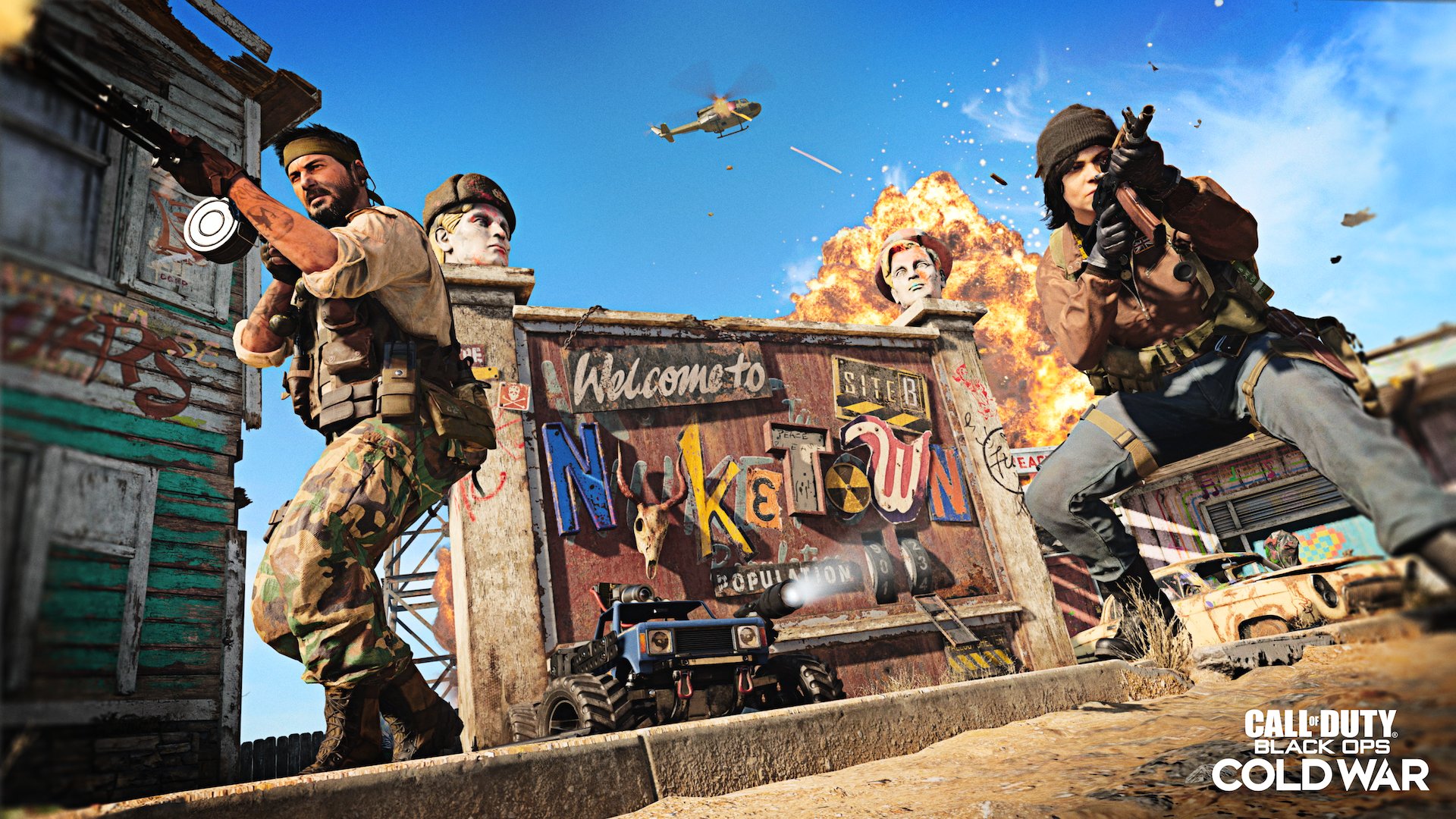The latest version of Call of Duty's iconic Nuketown map has a somewhat ironic anti-war message
An unnecessarily deep analysis of a dumb multiplayer map.

Nuketown ‘84, the latest iteration of the eternal Call of Duty map, has an official backstory. It’s something to do with bohemians stumbling upon a decommissioned replica of the test site in the original Black Ops, and repurposing the place as a commune—a deeply ironic refuge from cold war anxiety. Then I guess the rent spikes? The misfits move out, spec ops move in, and rat-at-at-at neeeowm BOOM. I’m filling in Treyarch’s blanks at the end, there. It’s a flimsy premise for what is, after all, a multiplayer map. The real story starts every ten minutes or so, when the scoreboard resets.
That’s not to say that Nuketown ‘84 is about nothing. It’s stuffed with real-world symbolism and iconography. Even the stage itself, the white picket fence neighbourhood populated by mannequins, is pulled straight from fact. Specifically, a spot of desert northwest of Las Vegas where the US tested the effects of early nukes on brickwork, clothing, and tinned food—not to mention the unfortunate Utah residents who happened to live downwind.
If you want to look for cold war metaphor in Nuketown, you’ll find it. It’s a tiny battlefield—not quite to the point of absurdity, like Modern Warfare’s Shipment, but small enough that you’ll sometimes see your enemies spawn in from the ether. As such, the action is compressed, and each match begins with the atmosphere of a powder keg poised to explode.
In team modes, both sides tend to get entrenched—the exposed road that runs through the map’s centre functioning as a Berlin Wall-style death strip, overwatched by snipers in the windows. And Nuketown is nihilistic. No matter what happens, everyone dies at the end—burned up when the bomb finally drops in a post-match cutscene. It’s a cruel joke, in tribute to a war in which individual heroics seemed dwarfed by the everpresent threat of mutually assured destruction.
Black Ops: Cold War’s addition to that cutscene is an arcade machine in the foreground, hosting Activision’s 1981 hit for the Atari 2600, Kaboom!. Its screen flashes 'GAME OVER', before a shockwave topples the bottle of beer resting on the cabinet's roof, and flames melt the hardware. It's the same seam of irony that Fallout has mined for decades with Vault Boy, juxtaposing the bright, chirrupy presentation of US capitalism with the apocalyptic scenario that loomed over it for half a century.
Then there's the new graffiti that the map's recent residents have sprayed across the place. Love, rainbows, and most prominently, the universal peace symbol that originated as the logo for CND, the British Campaign for Nuclear Disarmament. CND enjoyed a major resurgence in the early ‘80s, as superpowers deployed new missiles and replaced old ones in an effective renewal of their cold war vows. Hundreds of thousands of protesters were attending anti-nuke demonstrations in London, and CND’s membership could practically be seen from space—certainly by the world leaders with their fingers on the nuclear button. In 1981, Glastonbury Festival emblazoned its famous Pyramid stage with the peace symbol, and called itself the ‘most effective Anti-Nuclear Fund Raiser in Europe’. It’s easy to imagine the unseen bohemians of Nuketown ‘84 in attendance.

Perhaps Treyarch picked ‘84 for its Orwellian ring, but there is a historical resonance to that year: the end of hope. 1983 marked the decline of the campaign, as Thatcher’s anti-CND government was reelected in the UK—defeating a Labour party that had promised unilateral nuclear disarmament. As left-wing politics crumbed across Europe, so too did the protests against cruise missiles.
Keep up to date with the most important stories and the best deals, as picked by the PC Gamer team.
There are two ways to look at Nuketown’s war on the ruins of the ‘80s CND movement. First, as a poignant and tragic reminder of how the decade played out. Or second, as a black comedy, with scorestreak planes napalm-crapping all over foolish notions of world peace. A confused tone is part and parcel of COD, so it’s only fitting that these questions hover, unanswered, over the map. For me, it’s the apparent contradictions that makes the series so deliciously complicated to dig into.

To play Nuketown now, of course, is to indulge in nostalgia for the map’s ‘00s heyday, when COD multiplayer was on top of the world, rather than its battle royale equivalent. It’s an odd feeling to have that memory layered with cold war-era reminiscence—not just the peace symbol, but the pop cultural artefacts. The arcade cabinets, Miami uzis, and synth-swathed lobby soundtrack.
The former citizens of the German Democratic Republic, which ended with the cold war, use the word ‘Ostalgie’—a pun that folds ‘ost’, meaning ‘east’, into ‘nostalgie’. But there’s some debate whether the term refers to a yearning for actual history, or a fantasy tangled up in lost youth and foggy memories. Today, Ostalgie is packaged up and sold to Germans as fondly remembered food brands, or DVDs of GDR state television. Perhaps it’s best to think of Nuketown in the same way: a commodification of half-recalled history, boxed up to sell to us once more.
Jeremy Peel is an award-nominated freelance journalist who has been writing and editing for PC Gamer over the past several years. His greatest success during that period was a pandemic article called "Every type of Fall Guy, classified", which kept the lights on at PCG for at least a week. He’s rested on his laurels ever since, indulging his love for ultra-deep, story-driven simulations by submitting monthly interviews with the designers behind Fallout, Dishonored and Deus Ex. He's also written columns on the likes of Jalopy, the ramshackle car game. You can find him on Patreon as The Peel Perspective.

